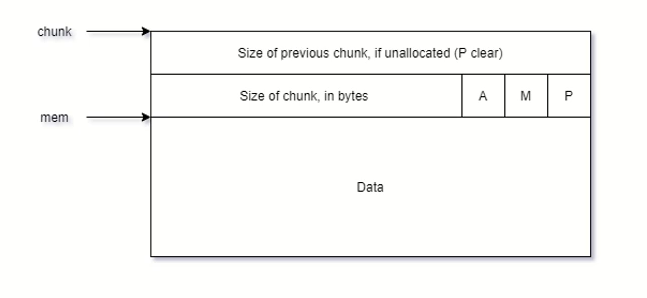概述以及数据结构
概述以及数据结构
1. What is heap
Heap is a memory region allotted to every program. Unlike stack, heap memory can be dynamically allocated. This means that the program can 'request' and 'release' memory from the heap segment whenever it requires. Also, this memory is global, i.e. it can be accessed and modified from anywhere within a program and is not localized to the function where it is allocated. This is accomplished using 'pointers' to reference dynamically allocated memory which in turn leads to a small degradation in performance as compared to using local variables (on the stack).
2. Related functions
malloc(size_t n)
Returns a pointer to a newly allocated chunk of at least n
bytes, or null if no space is available. Additionally, on
failure, errno is set to ENOMEM on ANSI C systems.
If n is zero, malloc returns a minimum-sized chunk. (The
minimum size is 16 bytes on most 32bit systems, and 24 or 32
bytes on 64bit systems.) On most systems, size_t is an unsigned
type, so calls with negative arguments are interpreted as
requests for huge amounts of space, which will often fail. The
maximum supported value of n differs across systems, but is in
all cases less than the maximum representable value of a
size_t.
free(void* p)
Releases the chunk of memory pointed to by p, that had been
previously allocated using malloc or a related routine such as
realloc. It has no effect if p is null. It can have arbitrary
(i.e., bad!) effects if p has already been freed.
Unless disabled (using mallopt), freeing very large spaces will
when possible, automatically trigger operations that give
back unused memory to the system, thus reducing program
footprint.
3. malloc_chunk
在程序的执行过程中,我们称由 malloc 申请的内存为 chunk 。这块内存在 ptmalloc 内部用 malloc_chunk 结构体来表示。当程序申请的 chunk 被 free 后,会被加入到相应的空闲管理列表中。
非常有意思的是,无论一个 chunk 的大小如何,处于分配状态还是释放状态,它们都使用一个统一的结构。虽然它们使用了同一个数据结构,但是根据是否被释放,它们的表现形式会有所不同。这是具体的微观数据结构,由这些所组成的链表即为堆块表。
struct malloc_chunk {
INTERNAL_SIZE_T mchunk_prev_size; /* Size of previous chunk, if it is free. */
INTERNAL_SIZE_T mchunk_size; /* Size in bytes, including overhead. */
struct malloc_chunk* fd; /* double links -- used only if this chunk is free. */
struct malloc_chunk* bk;
/* Only used for large blocks: pointer to next larger size. */
struct malloc_chunk* fd_nextsize; /* double links -- used only if this chunk is free. */
struct malloc_chunk* bk_nextsize;
};
typedef struct malloc_chunk* mchunkptr;
参数分析:
-
prev_size, 如果该 chunk 的物理相邻的前一地址 chunk(两个指针的地址差值为前一 chunk 大小) 是空闲的话,那该字段记录的是前一个 chunk 的大小 (包括 chunk 头)。否则,该字段可以用来存储物理相邻的前一个 chunk 的数据。这里的前一 chunk 指的是较低地址的 chunk 。
-
size ,该 chunk 的大小,大小必须是 2 * SIZE_SZ 的整数倍。如果申请的内存大小不是 2 * SIZE_SZ 的整数倍,会被转换满足大小的最小的 2 * SIZE_SZ 的倍数。32 位系统中,SIZE_SZ 是 4;64 位系统中,SIZE_SZ 是 8。 该字段的低三个比特位对 chunk 的大小没有影响,它们从高到低分别表示
- NON_MAIN_ARENA,记录当前 chunk 是否不属于主线程,1 表示不属于,0 表示属于。
- IS_MAPPED,记录当前 chunk 是否是由 mmap 分配的。
- PREV_INUSE,记录前一个 chunk 块是否被分配。一般来说,堆中第一个被分配的内存块的 size 字段的 P 位都会被设置为 1,以便于防止访问前面的非法内存。当一个 chunk 的 size 的 P 位为 0 时,我们能通过 prev_size 字段来获取上一个 chunk 的大小以及地址。这也方便进行空闲 chunk 之间的合并。
-
fd,bk。 chunk 处于分配状态时,从 fd 字段开始是用户的数据。chunk 空闲时,会被添加到对应的空闲管理链表中,其字段的含义如下
- fd 指向下一个(非物理相邻)空闲的 chunk
- bk 指向上一个(非物理相邻)空闲的 chunk
- 通过 fd 和 bk 可以将空闲的 chunk 块加入到空闲的 chunk 块链表进行统一管理
-
fd_nextsize, bk_nextsize,也是只有 chunk 空闲的时候才使用,不过其用于较大的 chunk(large chunk)。
- fd_nextsize 指向前一个与当前 chunk 大小不同的第一个空闲块,不包含 bin 的头指针。
- bk_nextsize 指向后一个与当前 chunk 大小不同的第一个空闲块,不包含 bin 的头指针。
- 一般空闲的 large chunk 在 fd 的遍历顺序中,按照由大到小的顺序排列。这样做可以避免在寻找合适 chunk 时挨个遍历。
我们称前两个字段称为 chunk header,后面的部分称为 user data。每次 malloc 申请得到的内存指针,其实指向 user data 的起始处。
当一个 chunk 处于使用状态时,它的下一个 chunk 的 prev_size 域无效,所以下一个 chunk 的该部分也可以被当前 chunk 使用。这就是 chunk 中的空间复用。
chunk-> +-+-+-+-+-+-+-+-+-+-+-+-+-+-+-+-+-+-+-+-+-+-+-+-+-+-+-+-+-+-+-+-+
| Size of previous chunk, if unallocated (P clear) |
+-+-+-+-+-+-+-+-+-+-+-+-+-+-+-+-+-+-+-+-+-+-+-+-+-+-+-+-+-+-+-+-+
| Size of chunk, in bytes |A|M|P|
mem-> +-+-+-+-+-+-+-+-+-+-+-+-+-+-+-+-+-+-+-+-+-+-+-+-+-+-+-+-+-+-+-+-+
| User data starts here... .
. .
. (malloc_usable_size() bytes) .
next . |
chunk-> +-+-+-+-+-+-+-+-+-+-+-+-+-+-+-+-+-+-+-+-+-+-+-+-+-+-+-+-+-+-+-+-+
| (size of chunk, but used for application data) |
+-+-+-+-+-+-+-+-+-+-+-+-+-+-+-+-+-+-+-+-+-+-+-+-+-+-+-+-+-+-+-+-+
| Size of next chunk, in bytes |A|0|1|
+-+-+-+-+-+-+-+-+-+-+-+-+-+-+-+-+-+-+-+-+-+-+-+-+-+-+-+-+-+-+-+-+
当chunk当中的数据被释放后会记录在链表当中:
chunk-> +-+-+-+-+-+-+-+-+-+-+-+-+-+-+-+-+-+-+-+-+-+-+-+-+-+-+-+-+-+-+-+-+
| Size of previous chunk, if unallocated (P clear) |
+-+-+-+-+-+-+-+-+-+-+-+-+-+-+-+-+-+-+-+-+-+-+-+-+-+-+-+-+-+-+-+-+
`head:' | Size of chunk, in bytes |A|0|P|
mem-> +-+-+-+-+-+-+-+-+-+-+-+-+-+-+-+-+-+-+-+-+-+-+-+-+-+-+-+-+-+-+-+-+
| Forward pointer to next chunk in list |
+-+-+-+-+-+-+-+-+-+-+-+-+-+-+-+-+-+-+-+-+-+-+-+-+-+-+-+-+-+-+-+-+
| Back pointer to previous chunk in list |
+-+-+-+-+-+-+-+-+-+-+-+-+-+-+-+-+-+-+-+-+-+-+-+-+-+-+-+-+-+-+-+-+
| Unused space (may be 0 bytes long) .
. .
next . |
chunk-> +-+-+-+-+-+-+-+-+-+-+-+-+-+-+-+-+-+-+-+-+-+-+-+-+-+-+-+-+-+-+-+-+
`foot:' | Size of chunk, in bytes |
+-+-+-+-+-+-+-+-+-+-+-+-+-+-+-+-+-+-+-+-+-+-+-+-+-+-+-+-+-+-+-+-+
| Size of next chunk, in bytes |A|0|0|
+-+-+-+-+-+-+-+-+-+-+-+-+-+-+-+-+-+-+-+-+-+-+-+-+-+-+-+-+-+-+-+-+
 已分配时的内存状况。
已分配时的内存状况。
 未分配的内存状况。
未分配的内存状况。
4. bin
bin就是用于管理空闲区域内的chunk的结构。
用户释放掉的 chunk 不会马上归还给系统,ptmalloc 会统一管理 heap 和 mmap 映射区域中的空闲的 chunk。当用户再一次请求分配内存时,ptmalloc 分配器会试图在空闲的 chunk 中挑选一块合适的给用户。这样可以避免频繁的系统调用,降低内存分配的开销。
在具体的实现中,ptmalloc 采用分箱式方法对空闲的 chunk 进行管理。首先,它会根据空闲的 chunk 的大小以及使用状态将 chunk 初步分为 4 类:fast bins,small bins,large bins,unsorted bin。每类中仍然有更细的划分,相似大小的 chunk 会用双向链表链接起来。也就是说,在每类 bin 的内部仍然会有多个互不相关的链表来保存不同大小的 chunk。
Referring articles:
- Preface - heap-exploitation (dhavalkapil.com)
- [堆利用入门]arena & heap info & malloc state - 简书 (jianshu.com)
- 堆相关数据结构 - CTF Wiki (ctf-wiki.org)




 浙公网安备 33010602011771号
浙公网安备 33010602011771号